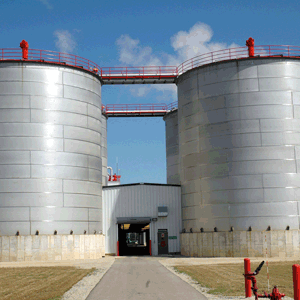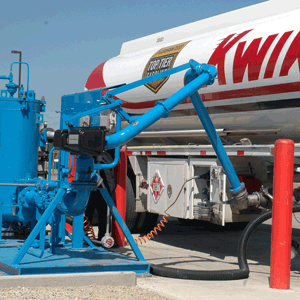Phasing Up to It





August 1, 2006
BY Dave Nilles
A pproximately 200 people toured United Wisconsin Grain Producers LLC (UWGP) as part of the 2006 International Fuel Ethanol Workshop & Expo in June. Many of those attendees likely thought the plant was spotless just for them. In fact, that's only partially true. The employees and investors of UWGP take great pride in their ethanol facility, according to UWGP CEO Jeff Robertson, who says the plant is kept "tour-ready" at all times, and for good reason.
UWGP began full-scale ethanol production May 1, 2005. While the grand opening was certainly a cause for celebration, it was tempered somewhat by the ethanol market, which was spiraling low enough to threaten the viability of some producers. "At the time, we were concerned with the expectations of our investors," Robertson says. "The price of ethanol had come uncoupled from the price of gasoline for a period of time."
Eventually, however, things rebounded, and—to the relief of UWGP's more than 800 investors—the market hasn't slowed down since, making the facility a source of pride for Friesland, Wis. In fact, things are going so well, UWGP officials are moving ahead with expansion plans on the 40 MMgy nameplate facility.
Following its first year of production, UWGP has been steadily producing at 50 MMgy. Therefore, Robertson doesn't consider the move to 80 MMgy a true doubling of capacity.
The plant will be expanded in two phases. The first phase will primarily tackle the liquefaction and fermentation areas of the facility. "Basically the front-end of the plant to the beer well," Robertson explains, noting that this area of the plant features the most throughput bottlenecks. Once the front end of the plant is operational, UWGP will study the back end of the plant to determine what is needed to reach 80 MMgy. "The idea is to not build capacity we don't need," Robertson says. "Eighty million gallons is the right volume for this plant with the corn supply in the area. Higher than that and we start to have a more serious increase in the price of corn."
At the planned new capacity, the facility would consume 28 million bushels of corn annually.
Another aspect being evaluated in the expansion is the addition of a corn defractionation system at the front end of the plant. The system would require less coproduct drying at the back end of the process, another efficiency for a producer that ships 70 percent of its distillers grains.
Defractionation would provide three product streams, one of which Robertson considers a potential fuel source. "One goes to the fermentors," he says of the starch. "The other two we do with as we see fit."
Removing the corn kernel's germ before conversion to ethanol produces distillers grains with a lower fat content. This allows for a higher inclusion rate in dairy cattle diets, Robertson says. The distillers grains may also have a lower phosphorous level, which is important in cattle feed.
Construction may begin within three months. Robertson hopes to have the expansion project complete by late 2007.
Friesland's close proximity to Madison—the town of 300 is located one hour northeast of the state capital—also gives UWGP the chance to lobby state officials. As part of the Wisconsin Ethanol Coalition, UWGP helped push for a statewide E10 requirement. Despite the proposed legislation being tabled, Robertson says it will likely re-enter discussions when the legislature reconvenes.
The failure of the E10 bill may be the biggest hiccup in UWGP's operations in the past year. For that, the plant's investors can be proud. "As the months have gone by, we've gotten more and more steady and smooth in operations," Robertson says. "There are very few upsets these days."
More information on UWGP can be found at www.uwgp.com.
Photos by Steve Stucko
UWGP began full-scale ethanol production May 1, 2005. While the grand opening was certainly a cause for celebration, it was tempered somewhat by the ethanol market, which was spiraling low enough to threaten the viability of some producers. "At the time, we were concerned with the expectations of our investors," Robertson says. "The price of ethanol had come uncoupled from the price of gasoline for a period of time."
Eventually, however, things rebounded, and—to the relief of UWGP's more than 800 investors—the market hasn't slowed down since, making the facility a source of pride for Friesland, Wis. In fact, things are going so well, UWGP officials are moving ahead with expansion plans on the 40 MMgy nameplate facility.
Following its first year of production, UWGP has been steadily producing at 50 MMgy. Therefore, Robertson doesn't consider the move to 80 MMgy a true doubling of capacity.
The plant will be expanded in two phases. The first phase will primarily tackle the liquefaction and fermentation areas of the facility. "Basically the front-end of the plant to the beer well," Robertson explains, noting that this area of the plant features the most throughput bottlenecks. Once the front end of the plant is operational, UWGP will study the back end of the plant to determine what is needed to reach 80 MMgy. "The idea is to not build capacity we don't need," Robertson says. "Eighty million gallons is the right volume for this plant with the corn supply in the area. Higher than that and we start to have a more serious increase in the price of corn."
At the planned new capacity, the facility would consume 28 million bushels of corn annually.
Another aspect being evaluated in the expansion is the addition of a corn defractionation system at the front end of the plant. The system would require less coproduct drying at the back end of the process, another efficiency for a producer that ships 70 percent of its distillers grains.
Defractionation would provide three product streams, one of which Robertson considers a potential fuel source. "One goes to the fermentors," he says of the starch. "The other two we do with as we see fit."
Removing the corn kernel's germ before conversion to ethanol produces distillers grains with a lower fat content. This allows for a higher inclusion rate in dairy cattle diets, Robertson says. The distillers grains may also have a lower phosphorous level, which is important in cattle feed.
Construction may begin within three months. Robertson hopes to have the expansion project complete by late 2007.
Friesland's close proximity to Madison—the town of 300 is located one hour northeast of the state capital—also gives UWGP the chance to lobby state officials. As part of the Wisconsin Ethanol Coalition, UWGP helped push for a statewide E10 requirement. Despite the proposed legislation being tabled, Robertson says it will likely re-enter discussions when the legislature reconvenes.
The failure of the E10 bill may be the biggest hiccup in UWGP's operations in the past year. For that, the plant's investors can be proud. "As the months have gone by, we've gotten more and more steady and smooth in operations," Robertson says. "There are very few upsets these days."
More information on UWGP can be found at www.uwgp.com.
Photos by Steve Stucko
Advertisement
Advertisement
Upcoming Events





